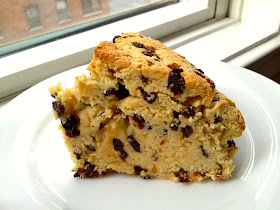Like many
holidays with a religious origin, St. Patrick’s Day has become a secular
observance in much of the United States.
The day celebrates one of the most recognized patron saints of Ireland
who brought Christianity to the island in the 5th century. He is also credited with banishing snakes
from the country, though scientific evidence suggests there were no snakes in
post-glacial Ireland.
While it
has not taken on the commercialism associated with Christmas, Valentine’s Day,
and Halloween, this holiday is often associated with bacchanalian revelry. On this night, Irish pubs and other watering
holes teem with some of the 36 million Americans that claim Irish ancestry (and
many others who make no such claims!) decked out in green shamrocks, clothing, accessories,
and face paint. While I tend to avoid
the crowds on this night, I decided to observe the occasion by baking soda bread—a
treat commonly made by North Americans on St. Patrick’s Day.
Traditionalists
complain that modern versions hardly resemble the original recipe, which was
limited to flour, baking soda, salt, and buttermilk. My formula includes a few
enhancements—caraway seeds, currants, egg, and a touch of sugar—but is
restrained in comparison to some cake-like creations. An online search revealed soda bread recipes
with chocolate, butter, orange zest, pastry flour, and loads of sugar; these decadent
items sound more like components of French pastries than the baked goods of the
formerly poverty-stricken Irish. One disparaging
online testimonial scoffed at the notion of orange zest in soda bread,
reminding the audience that oranges were a rare treat only given to children at
Christmas.
Thankfully,
we live in less austere times and so we can enjoy soda bread (and oranges) more
than once a year.
Serves 8-12
Ingredients
4 cups unbleached all-purpose
4 tablespoons sugar
1 teaspoon baking soda
4 cups unbleached all-purpose
4 tablespoons sugar
1 teaspoon baking soda
1 teaspoon salt
1 tablespoon caraway seeds
1 tablespoon caraway seeds
1 cup dried currants or
raisins
2 cups buttermilk
1 extra-large egg, lightly beaten
2 cups buttermilk
1 extra-large egg, lightly beaten
Directions
1. Preheat the oven to 375 degrees F.
2. In a large bowl, combine the flour,
sugar, baking soda, salt, caraway seeds, and currants/raisins.
3. In a small bowl, beat the buttermilk
and egg together.
4. Using a wooden spoon, add the wet
ingredients to the dry ones. Knead the
dough to incorporate all the ingredients and add additional buttermilk (in one
tablespoon increments) if needed. Do not
knead the dough too much. The dough
should be rough and craggy; it will not be smooth like dough that contains
butter and more eggs.
5. Shape loaf into a ball and flatten
slightly. Place it on a baking sheet
lined with parchment paper.
6. Score the loaf with an X that comes
almost to the edge of the loaf. The cut
should be about 1/4 inch deep.
7. Bake for 50 to 60 minutes, or until a
cake tester comes out clean. When it is
done, tapping the loaf will produce a hollow sound.
8. Cool on a baking rack for 5-10 minutes.
Serve warm or toasted with butter, jam,
or honey.
9. To freeze, cover with saran wrap and
place in an airtight container for up to 2 months.



No comments:
Post a Comment